Even if schools strived to offer the best support and equitable distance learning opportunities, this was not always possible. Not all educational institutions could properly equip all their teachers with technology to ensure a smooth remote teaching experience. Some students also fell behind because of outdated devices or weak internet connections.
This mix of factors increased learning gaps at individual, class, institutional, and state levels. Once they happen, learning gaps are hard to close. It takes weeks or even months to put students back on track. It’s not easy to make up for missing classes and competencies.
If technology is one of the main factors that kept learning afloat during the lockdown, it is also key in closing learning gaps. An intelligent learning platform (ILP) is one of the solutions schools can rely on for this purpose.
What are learning gaps in education?
Learning gaps are the difference between what students should have learned through a specific curriculum and what they learned in reality.
For example, in a foreign language class, the objective can be for students to progress from beginner to pre-intermediate level in one year. Students who demonstrate a beginner’s competency level by the end of the year have a learning gap.
Leaning gaps happen for different reasons:
- Students can’t attend classes due to illness or personal problems;
- Students voluntarily skip classes;
- Students drop out of school, then enroll again after a certain period;
- Students take a long break before moving to a different school;
- Students face emotional problems that prevent them from properly engaging in classes;
- Classes are canceled, rescheduled;
- Frequent teacher replacements;
- Schools constantly shift from remote to in-person classes, which causes confusion and adaptation difficulties, especially among younger students. According to a 2021 McKinsey report, disruptions such caused by the pandemic left K–12 students five months behind in some key subjects such as Math.
Learning gaps vary a lot in complexity and intensity. Some are quite easy to close. For example, a student missing one class is a problem teachers can tackle with a bit of extra support. On their side, students simply have to put in more effort to make up for that missing class through individual study.
Other gaps are harder to cope with, especially if they affect many students or the entire classroom. These gaps need careful analysis and prompt intervention, which requires the joint effort of teachers, parents, and other school staff members.
There are different types of learning gaps, but usually, they all fall into one of these five categories:
- Knowledge gaps stem from a lack of correct and sufficient knowledge; they can be caused by poorly planned teaching activities. For example, some teachers focused on handing out written assignments and lots of worksheets during the pandemic. While these are great teaching materials, they can’t substitute verbal explanations students need to receive in order to understand everything.
- Environmental gaps are caused by environments that don’t offer proper learning conditions, such as a distraction-free learning space and good internet connection. For the past two years, many students and teachers have had to make do with a less than ideal environment.
- Skill gaps often occur in education and are not always caused by major disruptions. Skills gaps open when students don’t have sufficient chances to practice what they’ve learned. This happens in classes that are too large or have hectic schedules. They can even stem from biases that cause some students to lag behind as they are not actively encouraged to participate in lessons.
- Motivation-related gaps are caused by intrinsic reasons; some students are more motivated to learn than others because they have higher self-efficacy and parental support, among many other factors that influence motivation. At the same time, external factors, such as teacher behavior, can lower or increase student motivation.
- Communication gaps were one of the biggest issues during lockdown. Teachers and students often experienced communication problems, particularly due to poor internet connectivity and outdated devices.Communication gaps are also caused by inefficient teacher-student communication, whether teaching happens online or in person. Asking for student feedback is key to tackling this problem.
How can teachers identify them?
Closing learning gaps is impossible without first identifying them. Teachers need to understand their nature, scale (how many students are affected), and come up with an action plan to close them. Learning gaps are rarely an issue time can solve. Students and teachers have to take active steps to close them.
The main ways to identify learning gaps are through observation and evaluation:
- Observation enables you to understand which students are up-to-date with their learning goals and have acquired the skills they need based on the curriculum. You can get a general idea by interacting with students during classes and checking their assignments;
- Evaluation is by definition the process of assessing students’ acquired skills. This is where learning gaps come to light. However, to truly identify and tackle learning gaps, grading tests is not enough. You also need to take into account their overall performance and progress to figure out how wide is the gap.
Learning gaps are easier to close thanks to learning technology that automatically tracks student progress and detects them early. So, teachers can close learning gaps faster, before they become harder to manage. The type of technology that has the highest potential to do this is the intelligent learning platform (ILP). This AI-based tool offers different goal and progress tracking features, as well as competency-based learning tools and custom content recommendations.
All of these features work together to help students acquire knowledge, prove their mastery, and slowly progress through the educational content at their own pace, thus avoiding learning gaps.
The end result is a lean learning, teaching, and evaluation process where no student is left behind. Thanks to this, more severe problems such as students dropping out of school can be avoided.
Read more: What is an intelligent learning platform for schools and universities?
Identifying and closing learning gaps through an intelligent learning platform
An ILP can help identify and close learning gaps via data analysis. Tapping into the immense potential of data is not just for the corporate world. Schools and universities can streamline their activity and provide better services by leveraging the potential of data.
Use competency-based learning
The first step in understanding how well a student performs is to make sure your classes offer relevant competencies and that these are clear and consistent with their content. ILPs have dedicated features that help you do this via competency-based learning. These capabilities allow teachers to associate competencies to the content they teach and the assignments students need to complete.
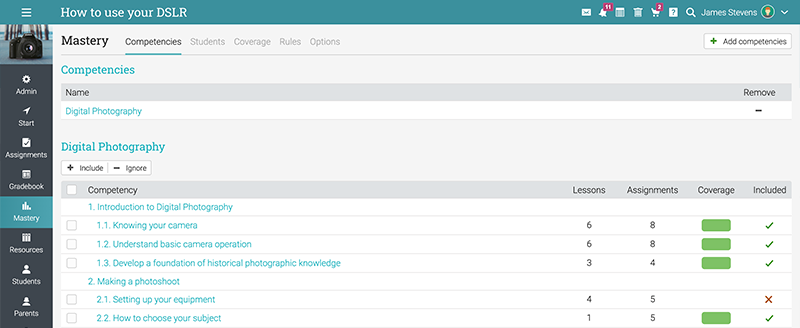 Associating competencies with lessons and assignments helps you track student progress for a specific competency.
Associating competencies with lessons and assignments helps you track student progress for a specific competency.
Students who don’t perform well don’t prove mastery of a certain competency. Therefore, they can go through the content again and retake the assignment. Only after successfully completing it, they can move on to the next topic.
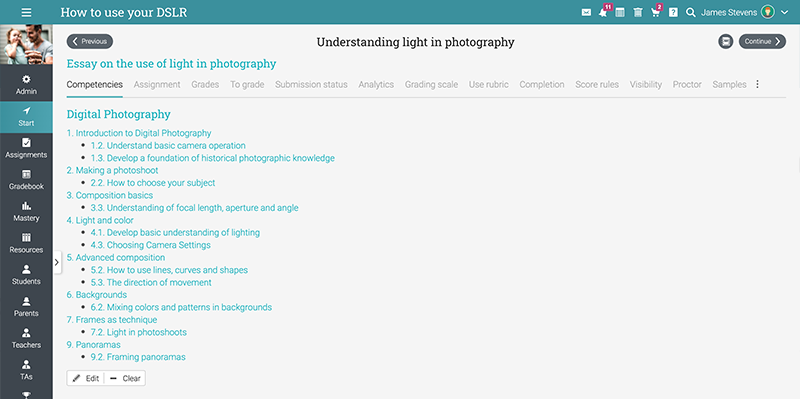 Adding competencies to assignments (quizzes, essay, team, etc.) allows you to evaluate student understanding.
Adding competencies to assignments (quizzes, essay, team, etc.) allows you to evaluate student understanding.
The ILP also provides a faster way to assess student knowledge via the ILP’s competency-related quiz system. By taking a quick quiz, students and teachers can immediately see where the first are at and if there are any knowledge gaps.
The platform checks quizzes in real-time and displays their results in an intuitive dashboard. Students can also rely on these quizzes to self-assess their competencies. Individual performance is available in the system, as well as a results overview of a larger group of users. These tests can serve at the beginning of the semester too. Teachers can use them as a diagnostic assessment to establish their students’ competency level.
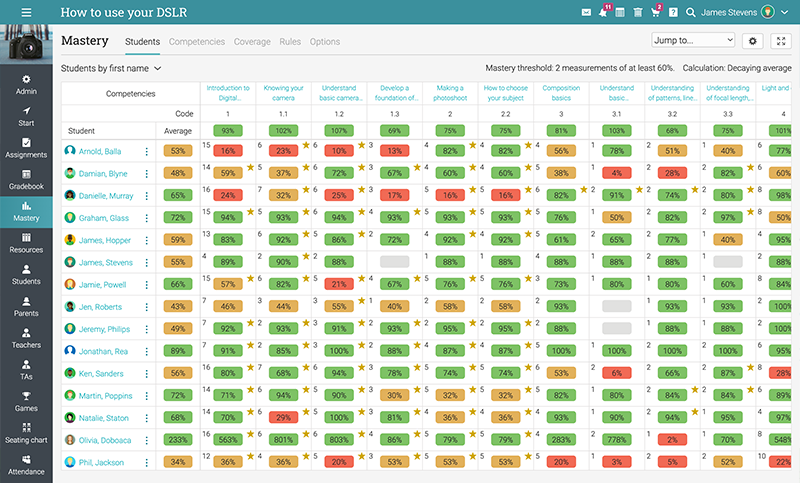 Then, you can see how well students are doing based on each competency.
Then, you can see how well students are doing based on each competency.
The purpose of competency-based learning is to ensure students acquire the skills they need before they progress to the next level. This is also one of the most efficient teaching methods that prevent knowledge gaps.
Read more: How to make competency-based education possible through an intelligent learning platform
Take actionable steps
Once teachers identify learning gaps, it’s very important to take action immediately. The ILP’s automation feature helps spot these gaps and also notifies teachers so they have the chance to do something about them.
All they have to do is choose the actions that they want to take.
For example, a teacher sets a necessary minimum threshold students must achieve in their class for a specific competency, such as:
- Set a score of 50 out of 100 points or a threshold of <50%;
- Or, use this score can be =<30%;
- Choose a range between two percentages such as =30% and <50%.
The idea is that it’s up to each teacher to evaluate what is the appropriate way to spot these learning gaps.
 The assignment threshold rule ensures that students who don't achieve a minimum of competency requirements can't move on until they do.
The assignment threshold rule ensures that students who don't achieve a minimum of competency requirements can't move on until they do.
If students don’t reach the percentage needed after completing their lessons and assignments, teachers can set specific rules to tell the platform what to do, which enables the platform to take action:
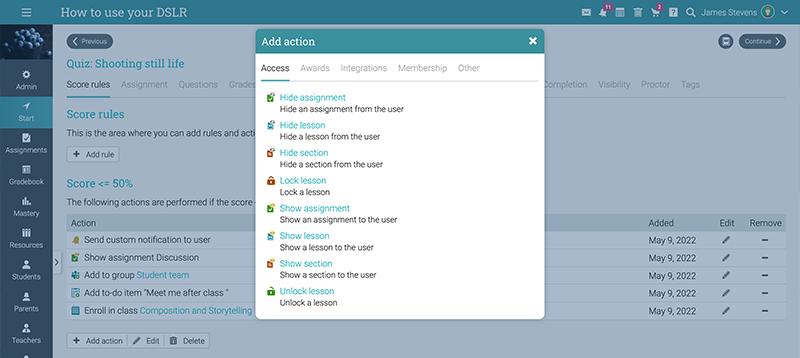 Think of the platform as a teaching assistant who observes what students do and prompts you and them to take action when learning gaps are detected.
Think of the platform as a teaching assistant who observes what students do and prompts you and them to take action when learning gaps are detected.
Here is a list of recommended actions that help close learning gaps:
-
Send a custom notification to the student to let them know what are the steps required for them to successfully master a certain competency;
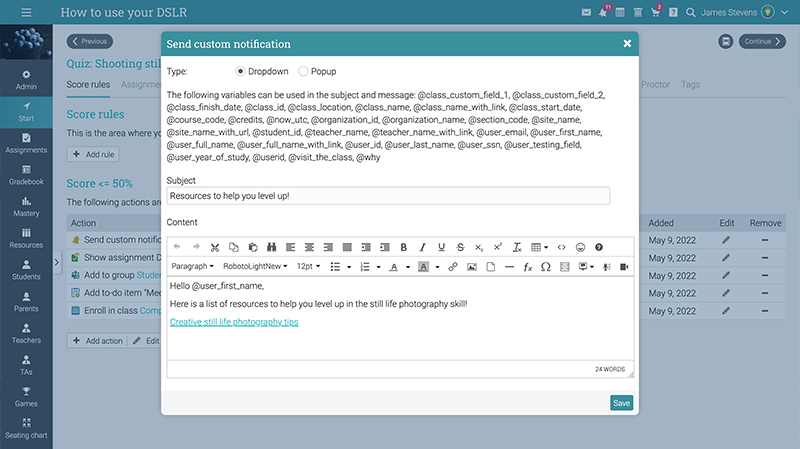 Custom notifications allow you to personalize the message.
Custom notifications allow you to personalize the message.
-
Having a one-on-one session with the student to discuss their challenges or use the ILP’s social tools (chats, groups, etc.). and send more resources to students who are failing to achieve mastery to help them improve their skills;
-
Automatically show or hide a lesson or assignment (or an entire section comprised of lessons and assignments). For example, you could show a special lesson that contains simpler explanations and tutorials to help them catch up. Alternatively, they can hide more advanced lessons so students don’t feel overwhelmed.
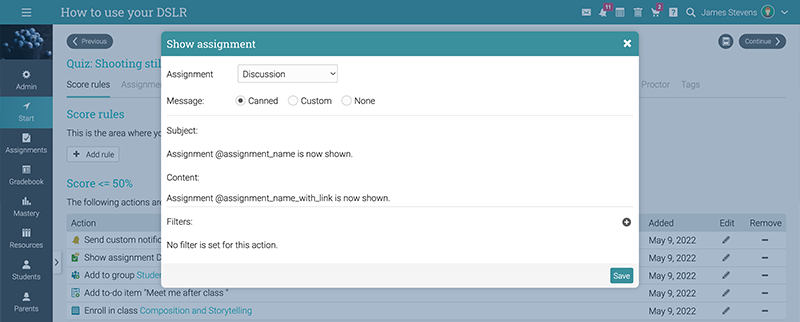 Show or hide content to students who don't achieve the minimum competency level requirement.
Show or hide content to students who don't achieve the minimum competency level requirement.
-
Add them to a study group in which students receive extra support from the teacher, teaching assistant, tutors, other students, etc. For example, if a student scores below 50% for a certain competency for a long time (for example, two weeks) the platform can add them to a study group.
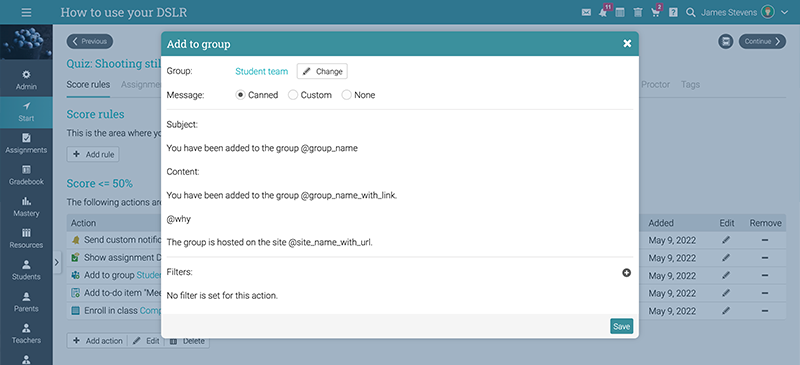 Automatically add students to relevant study groups that can help them catch up.
Automatically add students to relevant study groups that can help them catch up.
-
Add a to-do item such as: meet me after school lessons for extra explanations. Other to-do items can be: re-read the lesson, re-take the quiz, etc. This item will also appear on a student's to-do list so they won't forget to take action.
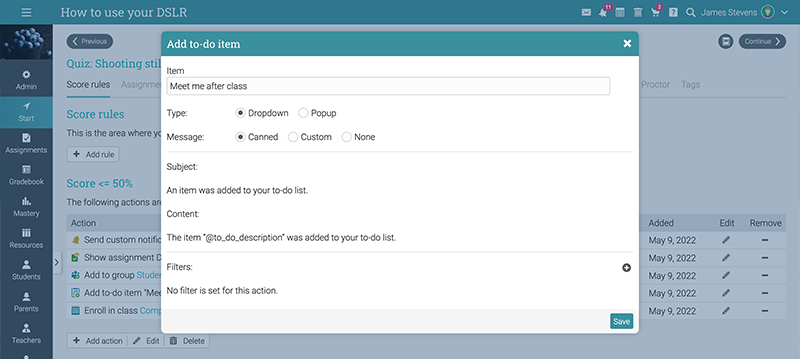 To-do items are great for telling students what they can do to improve their competency level.
To-do items are great for telling students what they can do to improve their competency level.
-
Enroll them in another class that you’ve created. For example, to help students close learning gaps, teachers can create a micro class that contains five-minute video lessons with extra explanations so they can work to understand a certain concept. This works great, especially for students who have missed certain pre-requisite competencies and can't move on to more difficult subjects before closing those learning gaps.
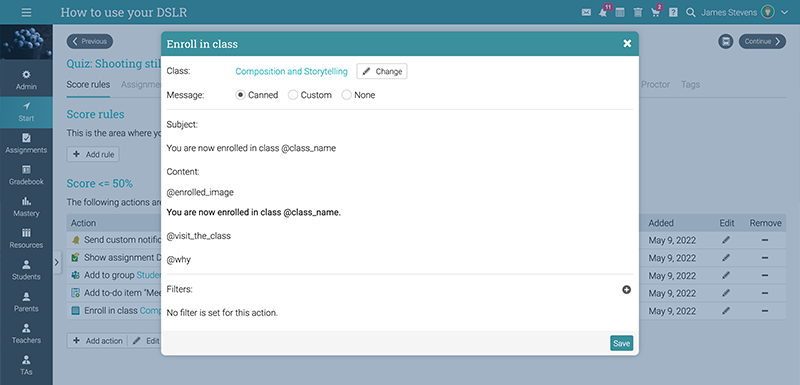 Enrolling students in another class can help them close learning gaps faster.
Enrolling students in another class can help them close learning gaps faster.
Enable personalized recommendations fueled by Artificial Intelligence (AI) algorithms
An ILP can help students close knowledge gaps, requiring minimum teacher intervention. This helps educators save time, especially when it comes to curating content and recommending the appropriate resources for students. This is possible thanks to these platforms’ powerful artificial intelligence (AI) algorithms. These algorithms analyze student performance and detect learning gaps.
This is how it works:
- The ILP does an automatic analysis of individual student performance. It takes into account the student’s overall activity: the classes they’ve completed, when, their results, past due classes, and others;
- Based on this analysis, the ILP can quickly spot learning gaps. For example, if the student’s progress drops below 50% on a specific competency, the platform automatically sends personalized content recommendations to help them improve their knowledge. The content is tailored to help them close learning gaps.
 The ILP does an automatic learning gaps analysis and comes up with the best recommendations for students.
The ILP does an automatic learning gaps analysis and comes up with the best recommendations for students.
Personalized recommendations can include:
- Taking classes created by their teacher or other teachers in that institution;
- Classes tailored to other grades or specializations;
- Third-party content from learning marketplaces such as Udemy;
- Relevant resources available on the Internet.
Thanks to this smart recommendations engine, teachers enjoy the benefit of having a virtual teaching assistant that makes sure students don’t lag behind on their assignments and competency achievement. Therefore, teachers can also tweak the recommendations engine according to what their students need.
Closing learning gaps is easier than ever before
Learning gaps in education are inevitable. Students don’t learn at the same pace and there are also external factors that affect their performance. However, teachers can spot and close these gaps with the help of technology. An ILP is one of the technologies that make this possible through accurate performance analysis and custom content recommendations.





